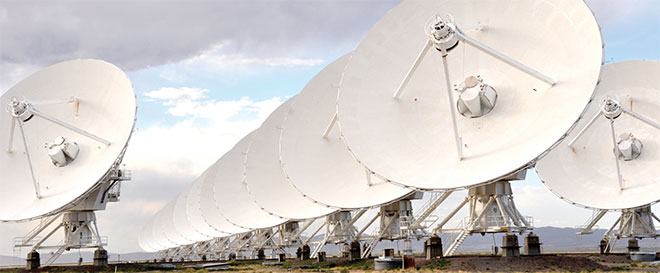Next Generation Very Large Array Workshop at the AAS
An NRAO Workshop at the Seattle AAS Meeting
Washington State Convention Center, Room 616/617
Sunday, 4 January 2015, 9am - 6pm PST

New Worlds, New Horizons laid out an ambitious panorama of astronomical discovery for this decade. Radio astronomy is playing a leading role in opening this discovery space, with telescopes such as the Jansky VLA, ALMA, and the GBT in the vanguard. Radio telescopes are imaging the earliest phases of planet formation, studying the cool dust and gas that drive star formation in galaxies across cosmic time, observing energetic and time varying phenomena ranging from compact stars to distant AGN, and testing the fundamental laws of physics and cosmology.
As we approach the mid-point in the decade, and anticipating exciting new observational capabilities from instruments like the Square Kilometre Array and the James Webb Space Telescope and TMT, the NRAO invites the community to consider the future of radio instrumentation in the coming decade, and beyond, at a one day workshop preceeding the AAS January meeting in Seattle. This Workshop, organized by NRAO and envisioned as the first in a series, is designed to broaden our discussions with the community, develop a deeper understanding of the future science opportunities at meter to submillimeter wavelengths, and foster new interactions with the US university community. This Workshop will include discussion of the scientific and technological opportunities and challenges in cm radio astronomy, as well as US and international interests in producing powerful new capabilities for the astronomy community.
The focus of this workshop will be on the scientific impact of a facility operating in the few cm to few mm regime with a substantially larger (factor 5 to 10) collecting area, and improved spatial resolution relative to the current VLA. Such a facility will open a new window on imaging cool thermal objects in the Universe at milliarcsecond resolution.
The Workshop will be an open forum for the discussion of new and expanded science areas for cm radio astronomy – a future science case. An important outcome of this meeting will be identifying the technological and operational developments that will be needed in the next decade to enable scientific progress. To facilitate and organize the discussion, working groups have been established to consider key science programs that could be addressed. The four working groups are:
- Cradle of Life: (proto-)planetary systems and formation; cloud cores to stars; astrochemistry/biology; Solar System; SETI
- Galaxy Ecosystems (baryon cycle): Galactic structure; interstellar medium and star formation; star formation laws, nearby galaxies; outflows and inflows; supermassive black holes (SMBHs)
- Galaxy Assembly through Cosmic Time (high z Universe): cool gas and dust; dynamics; Active Galactic Nuclei (AGN)/SMBHs
- Time domain, Cosmology, Physics: Transient sky; synoptic surveys; AGN physics; high energy phenomena; stellar phenomena; pulsars.
The Workshop will consist of invited talks by world experts in the field, breakout sessions, report-outs by the working groups, and open discussion. These working groups will be community-led, and we are hoping for strong participation from the US and international astronomy community. If you are interested in participating, please register using the "Register" link in the menu in the left column of this page.
Scientific Organizing Committee
- Juergen Ott (chair, NRAO), Tony Beasley (NRAO), Bryan Butler (NRAO), Chris Carilli (NRAO), Joe Lazio (JPL, CIT), Betsy Mills (NRAO), Emmanuel Momjian (NRAO), Karin Öberg (Harvard), Dominik Riechers (Cornell).
Local Organizing Committee
- Mark Adams, Dale Frail




Connect with NRAO